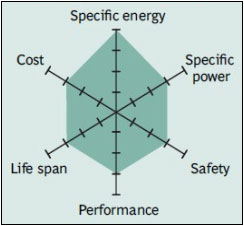You’re correct that the Volt’s and Leaf’s respective battery packs have nearly identical chemistry, both using a lithium-manganese cathode. They both have the same sensitivity to high temps. Out of all the various lithium cathodic chemistries, lithium-manganese is the most heat sensitive and has the highest and fastest rate of capacity decay and degradation at higher temperatures.
The Leaf’s battery cell is manufactured by NEC, is a pouch type cell with stacked elements, a LiMn2O4 cathode from Nippon Denko, a graphite anode from Hitachi Chemicals, a Celgard PP dry separator, and an EC type LiPF6 electrolyte from Tomiyama.
The Volt’s battery cell is manufactured by LG Chem, is a pouch type cell with stacked elements, a LiMn2O4 cathode from Nikki Catalysis, a hard carbon anode (which is more robust and has better/longer calendar life properties than the graphite anode in the Leaf’s battery cell) from Kureha, a Celgard PP dry/SRS separator, and a PC type LiPF6 electrolyte produced in-house by LG Chem.


